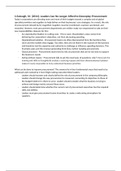Samenvatting
Summary of Purchasing Strategy and Systems - All required articles - University of Twente - MSc Business Administration
- Instelling
- Universiteit Twente (UT)
Summary of all requires articles for the subject "Purchasing Strategy and Systems" - University of Twente - MSc Business Administration. The summary contains the following articles: 1.Eatough, M. (2014). Leaders Can No Longer Afford to Downplay Procurement. 2.Capron L., & Chatain, O. (2008). Compe...
[Meer zien]





